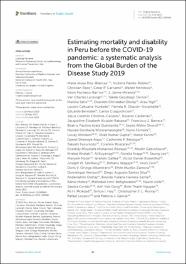Estimating mortality and disability in Peru before the COVID-19 pandemic: a systematic analysis from the Global Burden of the Disease Study 2019

View/
Download
(application/pdf: 9.084Mb)
(application/pdf: 9.084Mb)
Date
2023-06-22Author(s)
Rios-Blancas, Maria Jesus
Pando-Robles, Victoria
Razo, Christian
Mendoza, Walter
Carcamo, Cesar P.
Pacheco-Barrios, Kevin
Miranda, J. Jaime
Lansingh, Van Charles
Gezahegn Demie, Takele
Saha, Manika
Okonji, Osaretin Christabel
Yigit, Arzu
Cahuana-Hurtado, Lucero
Chacón-Uscamaita, Pamela R.
Bernabe, Eduardo
Culquichicon, Carlos
Chirinos-Caceres, Jesus Lorenzo
Cárdenas, Rosario
Alcalde-Rabana, Jacqueline Elizabeth
Barrera, Francisco J.
Metadata
Show full item recordAbstract
“Background: Estimating and analyzing trends and patterns of health loss are
essential to promote efficient resource allocation and improve Peru’s healthcare
system performance.
Methods: Using estimates from the Global Burden of Disease (GBD), Injuries, and
Risk Factors Study (2019), we assessed mortality and disability in Peru from 1990
to 2019. We report demographic and epidemiologic trends in terms of population,
life expectancy at birth (LE), mortality, incidence, prevalence, years of life lost
(YLLs), years lived with disability (YLDs), and disability-adjusted life-years (DALYs)
caused by the major diseases and risk factors in Peru. Finally, we compared Peru
with 16 countries in the Latin American (LA) region.
Results: The Peruvian population reached 33.9 million inhabitants (49.9% women)
in 2019. From 1990 to 2019, LE at birth increased from 69.2 (95% uncertainty
interval 67.8–70.3) to 80.3 (77.2–83.2) years. This increase was driven by the
decline in under-5 mortality (−80.7%) and mortality from infectious diseases in
older age groups (+60 years old). The number of DALYs in 1990 was 9.2 million (8.5–10.1) and reached 7.5 million (6.1–9.0) in 2019. The proportion of DALYs due
to non-communicable diseases (NCDs) increased from 38.2% in 1990 to 67.9% in
2019. The all-ages and age-standardized DALYs rates and YLLs rates decreased,
but YLDs rates remained constant. In 2019, the leading causes of DALYs were
neonatal disorders, lower respiratory infections (LRIs), ischemic heart disease,
road injuries, and low back pain. The leading risk factors associated with DALYs
in 2019 were undernutrition, high body mass index, high fasting plasma glucose,
and air pollution. Before the COVID-19 pandemic, Peru experienced one of the
highest LRIs-DALYs rates in the LA region.
Conclusion: In the last three decades, Peru experienced significant improvements
in LE and child survival and an increase in the burden of NCDs and associated
disability. The Peruvian healthcare system must be redesigned to respond to
this epidemiological transition. The new design should aim to reduce premature
deaths and maintain healthy longevity, focusing on effective coverage and
treatment of NCDs and reducing and managing the related disability.“
Collections
- Web of Science (WOS) [236]

